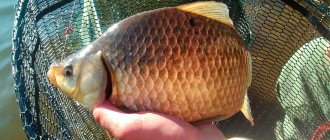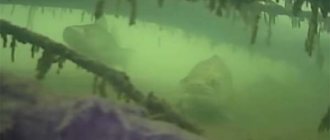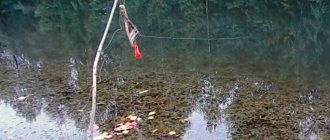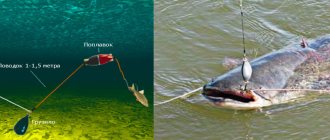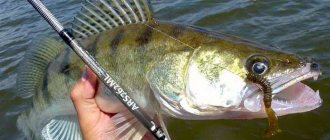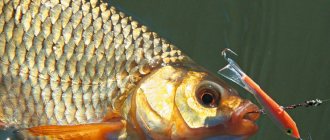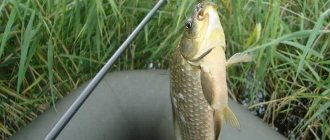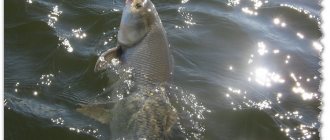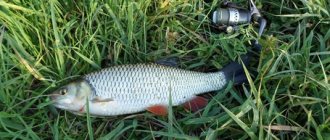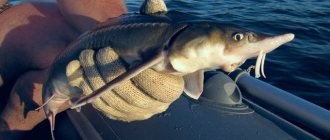Buy quality products at affordable prices in the best fishing online stores
. Give gifts to yourself and your loved ones!
we are in social networks
— subscribe to us on Facebook, Youtube, VKontakte and Instagram. Stay up to date with the latest site news.
Ide is not a purely bottom-dwelling fish, like bream or tench. It feeds in the water column 10-15 cm from the bottom. It is found in medium and large rivers in areas with slow and medium flow. Groundbait for ide is somewhat similar to roach bait. It should be quite loose and at the same time nutritious. In this article we will look at the main options for bait mixtures for catching ide on the bottom.
Since ide feeds in the bottom layer, it is probably better to equip the bottoms with springs or method feeders with leads from 5 to 15 cm, and put foam on the hooks. This way the nozzle will be 5-15 cm from the bottom.
Recipe No. 1
To prepare this bait we will need the following ingredients:
- Boiled peas – 1 kg
- Flax seeds – 300 grams
- Bran – 600 grams
- Semolina – 300 grams
- Fish food – 100 grams
- Chopped worms – 200 grams
- Dry clay – 200 grams
We use half peas and cook for about 30 minutes. We follow the proportions: for 1 cup of peas, 3 cups of water. Then fry the bran and flax seeds. Grind the seeds in a coffee grinder and mix them with breadcrumbs. Add this mixture to the peas. Add the rest of the ingredients there too. Mix everything well to a viscous mass and check how it molds and works in water. Since the composition contains many fine-grained components, the bait should create excellent dust in the water. To check this, roll balls of different diameters and place them in containers with water. Let's see how quickly the elements will separate from the balls.
If we observe how bran, flax and fish food float up, while forming a cloud of turbidity, then the bait is working and suitable for catching ide. It can be used. If we do not observe active separation of particles, then we add crackers to its composition.
When fishing, we evaluate the strength of the current and how well it is to sculpt balls. You can feed using feeders and throwing balls at the same time. The goal is to create a small feeding spot and force the ide to eat not only small particles, but also the peas that will lie on the bottom.
Catching ide on a donk
Catching ide with a donk is attractive, first of all, because the fisherman only needs to cast the tackle and patiently wait for the moment of a bite, unlike float fishing or actively catching ide with a spinning rod. You can fish with donkeys from early spring until late autumn, until the reservoirs are covered with ice. But it is still most successful in the spring, the first few weeks after spawning and during the summer.
- For a fishing rod, we choose a feeder, up to 2.5 meters long, of medium hardness, with a tip that allows you to throw loads weighing up to 30 grams.
- It is not recommended to use longer rods, as this will significantly reduce the sensitivity of the gear, and accordingly, fish strikes will become more frequent.
- We choose a more powerful reel, with high power characteristics, since at first glance this quiet and slow fish offers significant resistance when fishing.
- An important point is the choice of fishing line. The determining factor here is the casting distance. For example, monofilament is best used at distances of up to 50 meters. And for long casts I recommend using braid, since it is practically inextensible, which is especially important when landing fish over long distances.
The equipment of a bottom rod can be sliding, but most anglers still attach the load to a separate leash. In areas of the reservoir with a moderate current, leashes with a length of 30 to 40 cm are used. The current stretches the line with the leash and all bites are clearly felt using the rod tip. In areas with counter currents, we use a shorter leash, up to 15 cm long.
All kinds of insects and their larvae are usually used as bait for catching ide with a donkey. These can be grasshoppers, gadflies, maggots, chafers, bark beetles, and caddis flies. Catching ide can also be effective using baits of plant origin - steamed peas or pea porridge. It can also be successfully used as bait.
Bait is important. Ide always reacts to a strong smell, so we make it simple, but fragrant.
- To do this, fry bread crusts in sunflower oil and mix it with steamed cake and grain.
- Then add earth and clay to the resulting mixture and make balls the size of a fist. The bait is ready!
In addition, ide can be attracted by burnt bird feathers, bunches of birch twigs and other fragrant plants.
By its nature, the ide is a very cautious fish; during the day it stays in the warm upper layers of water and often goes out onto riffles and sandbanks. At the slightest danger, it immediately leaves, so the fisherman must be extremely careful. At night it stays near areas with sharp changes in depth. In this case, the tackle is cast against the current, then the line is pulled closer to the expected location of the fish. At times, to catch ide, you should use bait, laying it a few days before the start of fishing.
Recipe No. 2
To prepare bait for this recipe we will need the following ingredients:
- Roasted seeds: 500 grams
- Breadcrumbs: 1 kg
- Boiled peas: 200 g
- Hercules: 40 g
- Semolina: 200 g
- Wheat bran: 300 g
- Sweet corn: 150 g
- Maggot: 2 standard servings
- Bulk vanilla flavoring
Mix all ingredients well, except maggots. We will add maggots while fishing. First, we add them to the bait for starting feeding with balls. We throw 6-7 balls. Then we add it in pinches to the feeders while fishing.
Where to look and when to catch
Ide is widespread in the European part of the continent and Siberia, and is found in many rivers of Asia. It feels most comfortable in large and deep flowing bodies of water with moderate currents. It can also live in a lake, provided that it is connected to a large river and there is water movement at the confluence.
Catching ide on the river begins with searching for a promising place. There are several areas where he likes to camp. So, ide usually holds:
The fished object loves depth; only hunger can drive it out into shallow water. Fishing in shallow waters will not bring the desired result, except in the spring, when the ide, weakened after spawning, is forced to go to the coastal zone rich in food in order to quickly restore strength. There is always plenty of food here, but there are also a lot of predators, so he doesn’t stay here for long.
Fishing for ide in spring, summer and at the end of the season will be productive in the morning and in the evening. In the hot daytime, only roaches chasing insects are caught on the hook, and even those are rare. This fish can provide a good bite throughout the day in cloudy, windless weather.
It is best to start fishing at dawn or a couple of hours before sunset. If the reservoir is located far from home, you will have to leave in advance.
Recipe No. 3
To prepare this bait we need the following components:
- Steamed wheat: 2 kg
- Oatmeal – 1 kg
- Makukha – 1.5 kg
- Ground mayfly – 200 grams
- Bloodworm 200 grams
- Maggot – 100 grams
- Dried blood – 300 grams
- Dry clay – 300 grams
We steam the wheat in a thermos or cook it in a saucepan. After that, add the remaining components. We add live components while fishing. We use bait in the same way as the previous one.
Description and behavior characteristics
Ide is one of the representatives of the carp fish species that lives in the middle latitudes of our country. The fish has an oblong body, covered with dense small scales with a metallic sheen that has a golden tint. The fins of the fish are painted scarlet or deep red. The small size of the head makes it possible to distinguish the ide from its closest relative, the chub, which is ideally similar in other shapes and colors. When catching ides, the angler most often comes across specimens up to two kilograms, although in nature the fish can reach five or six kilograms of mass and a length of more than half a meter.
The fish leads a rather hidden and cautious lifestyle, staying at depth in waters rich in oxygen. Roaches, gathering in flocks, feed on plant foods and mayflies. Adult fish lead a solitary predatory lifestyle, hunting for fry and frogs, not disdaining plant food and insect larvae. Based on the diet, one of the important features in catching ide is the effective use of artificial baits that imitate the behavior of fry.
Recipe No. 4
To prepare this recipe we will need the following ingredients:
- White breadcrumbs – 2 kg
- Flax – 500 grams
- Cinnamon – 200 grams
- Peanuts – 1 kg
- Powdered milk - 400 grams
- Banana – 300 grams
- Coriander – 100 grams
- Ground clay – 1 kg
- Bran – 1 kg
- Sugar – 200 grams
- Feed bloodworm 200 grams.
Grind the peanuts in a coffee grinder until a paste forms. Add crackers and dry milk to it. Mix everything in a large container until everything fits.
Next, gradually add sugar and bran and the remaining ingredients, except for the feed bloodworm. We'll add it while fishing. This bait has good viscosity due to the clay. The starting feeding is carried out with 6-7 balls into the fishing zone to create a carpet of bait measuring 1 by 1 meter.
It is convenient to add bait to the spring and method feeder. When casting, it does not crumble and reaches the bottom. After landing, many small particles quickly rise into the water column and attract a large number of ides of different sizes.
☸ Fishing methods
Since ide is an omnivorous fish, it can be caught using a variety of baits, from filamentous algae to wobblers. This means that there are also plenty of fishing methods. Among the sports methods, the most popular are the float rod, fly fishing tackle, English donka (feeder) and spinning rod. Let us briefly consider some of the nuances of their use.
⚓ Fishing with a float
Catching ide from the shore with a fishing rod is an extremely emotional activity. When a thin rod bends into an arc and begins to seem as if it is about to crack, the angler receives an incomparable experience.
To experience this, you need to thoroughly prepare for fishing: collect strong and at the same time quite sensitive gear, do not forget to take a landing net and wading suit, since most often they fish by wading with a fishing rod.
⚓ Fly fishing tackle
Fishing for ide with fly tackle is usually carried out at a depth of up to 2 meters. The fisherman enters the water and releases the blind rig with bait behind the current. That is, it catches the wiring. The most promising areas for this method are considered to be areas with shellfish, which this fish often visits in the first half of summer.
And here's what you need to know: Catching perch in the summer with a float rod
Recipe No. 5
This bait also consists of a large number of fine-grained components, which are very attractive to ide. The presence of a large number of cookies makes it very fragrant and sweet. To prepare it we will need the following components:
- Corn flour – 1 kg
- Corn grits medium grind – 1kg
- Vanilla cookies – 2 kg
- Oat flour – 1 kg
- Hercules flakes - 0.5 kg
- Bran – 1 kg
- Rye breadcrumbs – 1 kg
- Sea salt – 80 grams
Place all ingredients in a bowl and mix well. You can use a screwdriver with a whisk. We take 3 kg of this bait for fishing. Upon arrival for fishing, add another 500 grams of ground fried peanuts and fried seeds. Add a little more sunflower oil to the seeds immediately after grinding.
After this, add more dark soil or clay. For 1 kg of bait you will need 0.5 kg of soil.
It is best to use soil that contains worms. They leave behind mucus with a smell that fish like. This way the soil will have its own aromatics. Next, you need to sift the soil through a medium-sized sieve so that there are no lumps. After this, the soil is dried a little and a liquid flavor is added to it. You can use fruit molasses.
At the last stage, add soil to the bait and mix well in a bucket or basin, using a whisk or, if not, then with your hands. We use bait in the same way as the previous one.
Groundbait for ide
Bait plays an important role when catching spring ide, the activity of which increases noticeably as the water warms up. The fish usually return to feeding places again. Large ide is no exception, although its food base is typical for predatory fish: pike, pike perch, etc.
If possible, then 2-3 days before fishing you should use bait. Boiled peas for fishing, mixed with cake, are placed in a piece of nylon stocking. It is advisable to mix in crushed bait. To ensure that the bait is washed out, holes are made in the bag. Fabric bags can be replaced with large feeder feeders to quickly flush out food.
To feed ide on the day of fishing, purchased mixtures for carp fish are suitable. Baits that are mixed to suit the taste characteristics of the fish in a particular body of water work well.
A practice-tested recipe for bait for ide:
- Purchased mixture for carp fish – 1 part;
- Boiled porridge from peas and wheat - one part each;
- Crushed cake or ground roasted seeds – ½ part;
- Bran or milk powder – ½ part;
- Small or chopped bait - a tenth.
When preparing ingredients, it is not necessary to meticulously count their quantities to the gram. Usually the volume of components is determined “by eye”. Additional flavorings may not be used. The desired consistency of the bait is achieved by adding clay or fishing glue. Clay and fishing glue can be used together.
Promising places
It’s worth saying right away that ide lives in rivers with fairly large depths and gentle currents. It is also found in large lakes, but only in flowing ones. A clean environment is one of the main conditions without which this fish simply cannot survive. The water may even be a little salty, but not cloudy or dirty.
Most of the time, ide prefers to stay at depth. Periodically, it goes out into shallow areas of the reservoir to search for food. You can catch it at shallow depths in the spring, during the post-spawning period. In summer, it can rise to the upper horizons and collect fallen insects from the surface, but after feeding it always returns to the depths. It should also be caught there in the fall.
Where are the ide sites located?
First of all, experienced fishermen advise paying attention to the following areas:
It is in such areas that you need to look for ide. Here, in one fishing trip you can “raise” more than a dozen heads, but you should know that only young animals lead a school lifestyle, while large individuals usually stay apart, alone.
